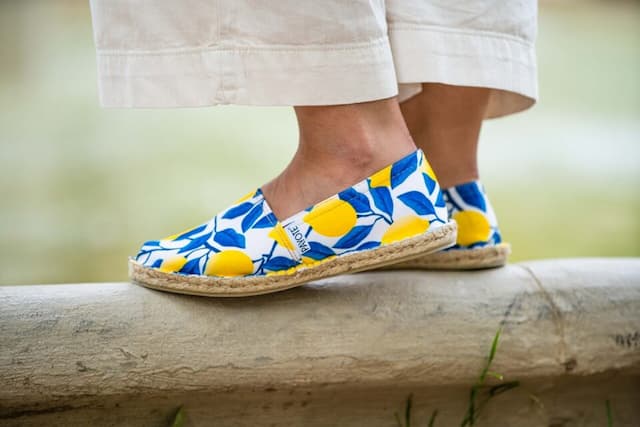How to Take Good Care of your Sneakers (and Prevent them from Smelling)

The espadrille is still and always a summer classic. But for your pair to last more than one season, it must be maintained. And your feet will thank you.
“In sneakers, we look like an idiot, we have blisters, we dance disco. In sneakers, it stinks of feet, in sneakers! ” Fans of Les Nuls will have recognised the mythical false advertising concocted by Alain Chabat’s team in the 1990s, and which already pointed to a real fundamental problem: why the espadrille is synonymous with a bad smell?
While the espadrille is still and always a timeless summer item, actu.fr has looked at this light shoe with a rope sole, the maintenance of which remains delicate.
The espadrille, canvas and rope
We recognise the espadrille by its shape and its characteristic materials: a cotton canvas to wrap the foot and a rope sole, made from jute. Today, most have also integrated a “layer of rubber under the sole, for durability”, underlines Marine Yamanaka, a spokesperson for the Payote espadrille brand, based in Perpignan, but which are manufactured in “the capital” of the espadrille, Mauléon-Licharre (Pyrénées-Atlantiques), in the Basque Country.
Apart from this classic shoe, there are also ribbon espadrilles or wedge espadrilles. Apart from the plain or sailor fabrics, which are the classics of the genre, today the new patterns of espadrilles fabrics, like new materials, bring a new breath to the espadrille. Up to luxury houses like Saint Laurent, Louis Vuitton or Ralph Lauren, who have designed their own.
How to prevent espadrilles from smelling?
It’s a label that sticks to the espadrille: when you wear them, they stink, and with it, the feet of their owner too. But is it really inevitable? At the risk of disappointing you, alas yes, as confirmed by Marine Yamanaka.
As the sole is made of braided rope, and humidity will not go well with this material. And as it gets wet, bad odours appear.
With the rope, there is no miracle solution. If you sweat a lot, it is better to avoid wearing your pair of sneakers every day, but rather every other day, to give them time to dry. And it is of course necessary to avoid wearing them on rainy days, prefer sunny days.
In an attempt to correct the problem, some brands (such as Payote) then offer perfumed sprays, so that the sneakers smell good all summer long.
Some also recommend “techniques based on talc, which would absorb moisture or even baking soda, but these are grandmother’s tricks, not scientifically proven”, notes Marine Yamanaka.
How to clean the canvas part of the espadrille?
Clean the canvas part on the other hand, it’s easier, like removing a stain for example. Marine recommends placing a tea towel or a piece of cloth in the shoe as a precaution, to protect the rope, then gently rubbing the stain with a toothbrush, Marseille soap or dishwashing liquid.
Then you have to let them dry. As with the rope sole, the professional recommends not exposing them too much to direct sunlight.
So many little precautions that will make your espadrilles well-maintained shoes that, perhaps, won’t smell too much.
How then to increase the lifespan of the espadrille?
And if not, is it so bad since an espadrille is not really made to last? “On the contrary”, tempers Marine, recognizes that it certainly remains a “perishable product, depending on its use and the level of perspiration” of its owner. But now, we are trying to “increase the durability of the sneaker” so that it can be used for several seasons.
Already, the quality of the espadrille can obviously make the difference between an espadrille made in France and another from abroad, especially from Asia.
The materials will obviously contribute to its lifespan, whether the outsole is rubber or the seams in nylon, instead of cotton, to gain resistance.

A French and European but also Asian production
In 2015, the French Footwear Federation estimated that 4 million pairs of espadrilles were sold in France, and among them, around 800,000 pairs only produced in the country. Today, “impossible to have a solid estimate” on the number of total sales, assures the French Footwear Federation.
“Between market sales, undeclared sales…”, this espadrille market, which remains niche, is “very difficult to follow”, we are told.
According to estimates by French producers, some 800,000 espadrilles are produced in France each year.
At the time, it was in Mauléon, in the province of Soule, that there were the largest espadrille factories in the 19th and 20th centuries. Today there are only 3-4 workshops left but it is still there that the majority of French espadrilles are made.
To recognize Made in France sneakers, the Payote spokesperson recommends checking the label, to verify the country of origin. “If there is no label, you can be pretty sure that it is a sneaker made abroad, especially in Bangladesh or China. Among the other producing countries, we can also mention Spain and Italy.
As for French brands, we find Prodiso, Don Quichosse, 1910 Lartigue, Arangois, SAS Armaité, Nicoles Paries and even Zétoiles.
The espadrille a shoe that has been able to adapt
If the espadrille appears as a classic for many years, its use is however far from its origins. “We find traces of the espadrille in Spain, around the 1200s, among the infantrymen”, and if its origins are not clear, “they would come from the Pyrenees”, locates Marine Yamanaka, specifying that this origin is disputed for a long time between Spain and France.
“The espadrille was worn by the Spanish armies and the miners of northern France”, confirms on its website the Basque Country Tourist Office, specifying that “the establishment of hydroelectric plants on the Saison (a river, editor’s note) have made their manufacture more industrial”.
In 1881, the town of Mauléon was the first electrified town in France. Mauléon then experienced a period of prosperity, employing up to 1,600 workers at the height of demand at the beginning of the 20th century.
The espadrille was then “a flexible work shoe, easy to manufacture and inexpensive. It was worked at home or by craftsmen”, further details the tourist office, before at the end of the 1950s, it “began its decline, competed by Chinese and Spanish production”. Today, “still made in Soule, it is currently experiencing a resurgence in popularity and even represents 65% of production in France”.
Moreover, “since 2020, we really feel the demand increasing”, we note at Payote. Thus, by the end of 2024, the company plans to open a factory capable of producing one million espadrilles per year, as its founder, Olivier Gelly, recently explained to our editorial staff.
And if you are really a fan of the espadrille, take note of this date: August 15th is the espadrille festival in the capital of this shoe, Mauléon-Licharre.
Enjoyed this? Get the week’s top France stories
One email every Sunday. Unsubscribe anytime.


